#neolithic venus
Text
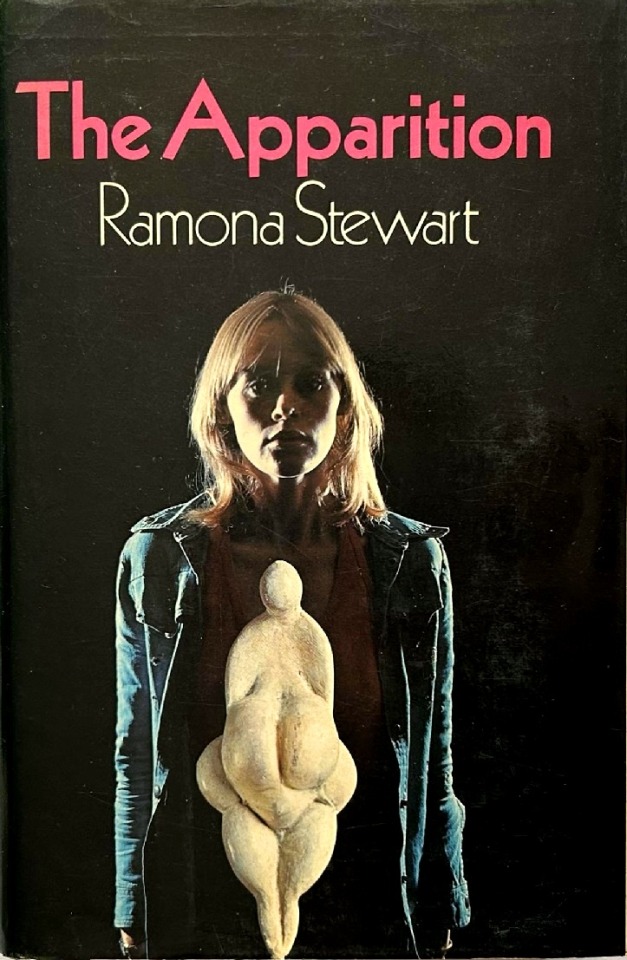
Ramona Stewart - The Apparition - Andre Deutsch - 1974
#witches#apparitions#occult#vintage#the apparition#abdre deutsch#ramona stewart#1974#neolithic venus
32 notes
·
View notes
Text
Time Travel Question 37: Ancient History XVII and Earlier
These Questions are the result of suggestions from the previous iteration.
This category may include suggestions made too late to fall into the correct earlier time grouping. Basically, I'd already moved on to human history, but I'd periodically get a pre-homin suggestion, hence the occasional random item waaay out of it's time period, rather than reopen the category.
In some cases a culture lasted a really long time and I grouped them by whether it was likely the later or earlier grouping made the most sense with the information I had. (Invention ofs tend to fall in an earlier grouping if it's still open. Ones that imply height of or just before something tend to get grouped later, but not always. Sometimes I'll split two different things from the same culture into different polls because they involve separate research goals or the like).
Please add new suggestions below if you have them for future consideration. All cultures and time periods welcome.
#Time Travel#Ancient History#Thera#Crete#Tekhelet#Jewish History#Fashion History#Troy#Western Asia#Ancient Greece#Greek Mythology#Gilgamesh#Sumer#Western Asian History#Pilipili#Trans History#Queer History#History of Religion#Venus of Willendorf#Neolithic#Early Humans#Chinese History#Wu Zeitan#Friesenhahn Cave#Homotheriums#Mammoths#Hominins#Dionysius#Greek Religion
111 notes
·
View notes
Text


Inktober day 3 - Neolithic fertility goddess human makeover
#art#drawing#sketch#artist#art history#ancient#ancient history#ancient art#neolithic#goddess#fertility#fertility goddess#Venus#makeover#human#humanized#inktober#art challenge
15 notes
·
View notes
Text

Venus of Malta
Date created: -4100/-2500
Found at Hagar Qim Temples, Malta
Ceramic
Neolithic
Period: Temple Period
National Museum of Archeology, Valetta
#found#art#sculpture#neolithic#Venus of Malta#sculptures of women#Malta#national museum of archeology#archeology#ancient history#the ancient world#pre christian art
6 notes
·
View notes
Text
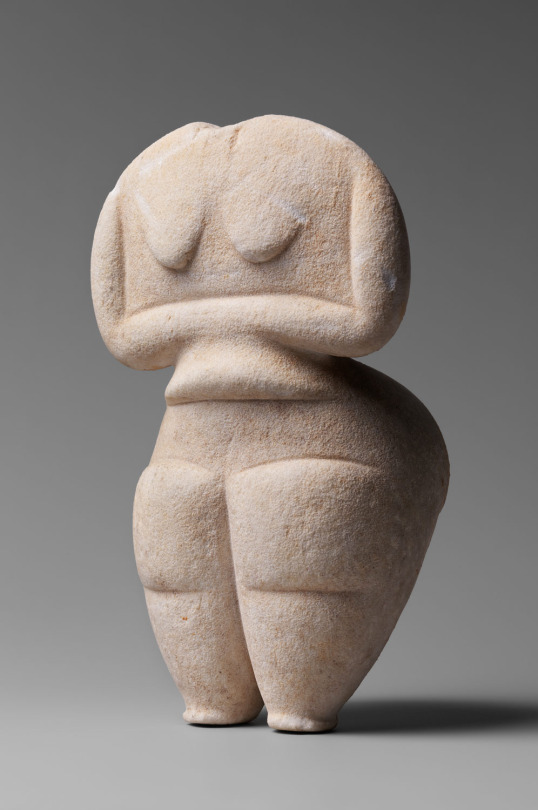
#ancestors#ancient history#ancient humans#neolithic#mesolithic#paleolithic#archaeology#hunter gatherer#Venus
5 notes
·
View notes
Text

The Westray Wife (also known as the Orkney Venus) is a small Neolithic figurine, 4 centimetres (1.6 in) in height, carved from sandstone. It was discovered during an Historic Scotland dig at the Links of Noltland, on Westray, Orkney, Scotland, in the summer of 2009. It was the first Neolithic carving of a human form to have been found in Scotland, and to date it is the earliest depiction of a face found in the United Kingdom.
~ Wiki
#The Westray Wife#Orkney Venus#Neolithic figurine#sandstone#Scotland#Links of Noltland#Westray#Orkney#Ancient Ways#SymbolSpeak#Goddess#Ancestors Alive!
1 note
·
View note
Text
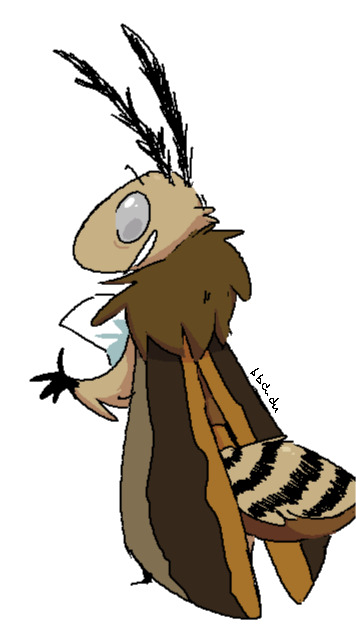
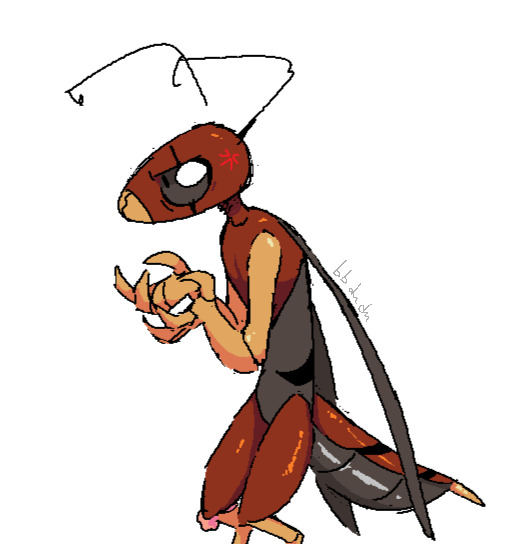

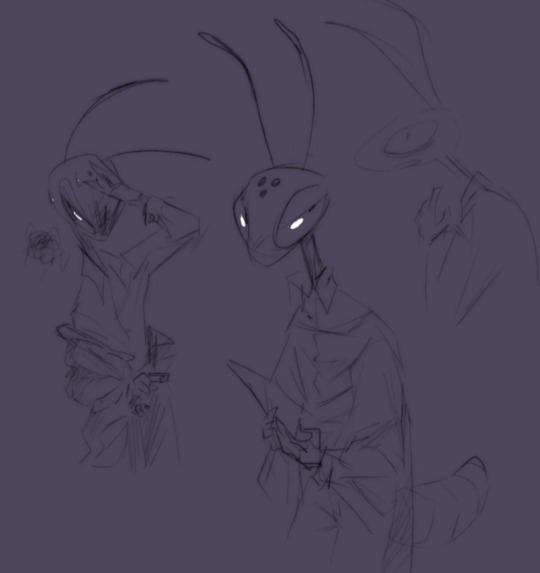
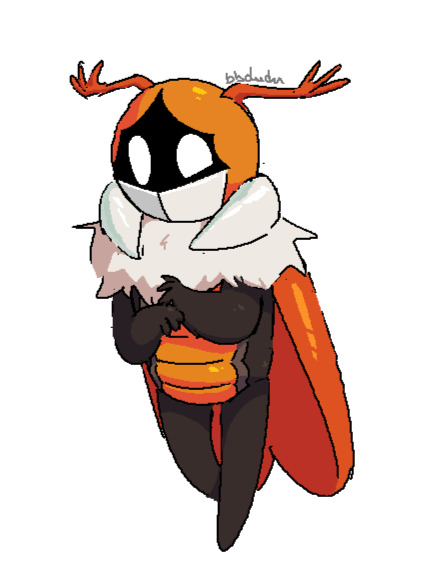
#bug fables#bug fables zasp#bug fables neolith#bug fables aria#bug fables venus#bug fables fanart#my art#bug-does-art-2023
140 notes
·
View notes
Text
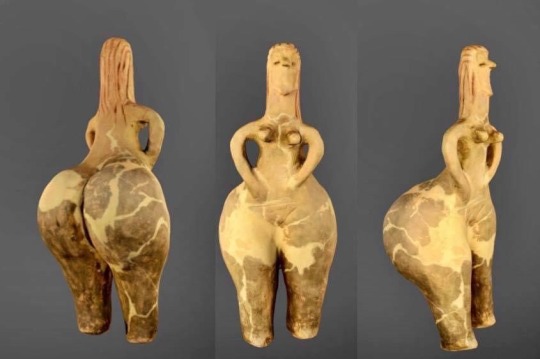
Neolithic Venus figurine called "Red hair goddess", terracotta, Starčevo culture, around 6300 - 5500 BC
7K notes
·
View notes
Note
Can I request a further rant on Alice Albinia's The Britannias please?
Anonymous asked: 'Further rant available upon request' here is my official request.
Aha. You are both prompt and accommodating. And it is my lunch break, so let's do this!
For context, this is the book in question:
This book was recently published, comes highly reviewed and (as I said) has apparently already been longlisted for some prestigious nonfiction writing/women's prizes. I got it from the library the other day and started reading it; I'm about 150 pages in. It has given me an increasing Itch to the point where lo, yes, here I am on Tumblr about to compose a Statement. This may be because of what the book blurb states upfront as its focus and goals:
Trespassing into the past to understand the present, The Britannias uncovers an enduring and subversive mythology of islands ruled by women. Albinia finds female independence woven through Roman colonial reports and Welsh medieval poetry, Restoration utopias and island folk songs. These neglected epics offer fierce feminist countercurrents to mainstream narratives of British identity and shed new light on women's status in the body politic today.
Okay... well. Basically, she wants to write a history of Britain as focused on its islands, which in itself is a perfectly valid thing to do. As she states in the introduction, focusing on the history of a place through its physically and geographically marginalized locations, its relation to the "mainland," the constructions of power and identity, how one resists and influences the other, is all a very interesting thing to do. It's just how she does it that gives me a twitch. Her clearly stated goal is to find a "hidden women's history" wherein these "fierce feminist countercurrents" are allowed to inform and eventually subvert a totally androcentric and oblivious mainstream British history that has apparently prevailed largely unchallenged ever since antiquity, and where the Male Process of History deliberately destroyed and excluded all female contributions. She is somehow, apparently, the first one to notice this and/or put it together.
Now I'll be honest, the Secret Magical Women trope also gives me a twitch wherever it appears, whether in saccharinely self-important historical or fantasy-historical fiction or in this case, attempted historical nonfiction. Albinia's thesis also seems, essentially, directly lifted from Marion Zimmer Bradley's Mists of Avalon fantasy series in the 1980s: the pagan Celtic/British tribes were egalitarian, proto-democratic, female-led and/or female-centric, and the conquering Romans/Christians/Saxons were all virulently misogynist, masculine, authoritarian, and determined to stamp out this wherever it appeared. I have only gotten up to about the year 1000 (it goes chronologically), so I can't speak to what rationales Albinia comes up with for the later centuries, but let me just say: Hmm. It says a lot about the overall style of this book that I read the first 10 pages and then immediately picked up my phone to check Wikipedia and see if she was a TERF. As far as I can tell, fortunately, she isn't, but it does give me the same binary gender-essentialist vibe (men are from Mars, women are from Venus), and yikes. Basically, there are a lot of things going on here, and all of them are Not Good when it comes to the actual practice and investigation of premodern women's history:
First, while Albinia cites a few research articles (via endnotes) and translations of primary sources (thus far, mostly Roman and early medieval) we know nothing about her qualifications for using these sources, how she is comparing and analyzing them, whether they should in fact be taken at face value, whether anyone else has written on these topics (spoiler alert: yes), or why we are supposed to buy her narrative of this Hidden Female History of Britain. For example: she includes several passages from Roman writers discussing (reported) actions or (reported) mythologies of British women or British female-associated places. These are presented as uncritical and general fact, or something which we should apparently assume was really happening as described, even when she (occasionally, and shallowly) points to the issue of using exterior and non-contemporary male writers from far away. Her analysis also does not touch at all on the potential metatextual or political impulses these Roman male writers might have for presenting a freshly conquered imperial territory as corruptly or unacceptably feminine, and whether this correlated at all to an overall real-world practice or belief. Yes, as far as we can tell, the ancient Celts were in some ways more "feminist" than the Romans, in that Roman public culture was deliberately and exclusively masculine and patriarchal and any civic participation by women in other societies would thus appear as more than usual. But that is a whole can of worms for many reasons, none of which are highlighted or dealt with here. (Like... are we even going to talk about how the "Roman standard" for society was itself re-created by the Renaissance and how that shapes Western historical views, or...?)
As I said above, the book completely brushes aside any of the previous existing scholarship on these topics (done, you know, by actual historians) and presents it as Albinia discovering these issues or formulating these arguments for the first time. She does mention a few other people whose work she relies on or who are informing her hypothesis, but several times thus far, this is from the 1920s or some other clearly outdated argument. Nobody in the field is still treating arguments made in the 1920s as au courant, and while I can't say for certain, it reads as her being more able to access older or public-domain work (since more up-to-date publications require institutional access or paying for copies) and doing the equivalent of the people on Wikipedia who cite the 1911 Catholic Encyclopedia for everything: they can get that text for free, so that's what they refer to. Now obviously, we all support uncovering feminist strands of history, doing feminist history, challenging heteronormative or patriarchal narratives, etc. But also, we support doing it well and making some reference to the complexity of it!!!!
Likewise, Albinia is a white British woman whose previous books are based on her time living and traveling in India and Pakistan (both of which are, uh, previously British colonies). I have not read them, so I can't speak to how she treats it, but there's certainly an element of exoticizing them here, and while she does make passing reference to the British Empire's effect on those places, she does a sort of weird inverse here. She obviously knows about the basic facts of empire and colonization, but there's a notable amount of time dedicated to portraying ancient/Celtic Britain as the helpless victim of constantly brutal Roman colonization (she makes a few very brief and offhand references to cultural miscegenation and how this process unfolded in ways apart from violence, but they are clearly secondary to her main thesis of this as a masculine rape analogy). She is very clear about mourning for this "sacred divine [female] Britain" which was then destroyed by the unrelentingly violent and misogynist forces of Roman (cultural/military) and Christian (religious) colonization, and as I said, that is straight up Marion Zimmer Bradley. I haven't gotten past said first 150 pages, but I'm not terribly confident that her historical analysis improves much in the centuries to follow.
The book does have some bright spots: it's well written, it's engaging, she includes some colorful and interesting sociological vignettes about life on the margins of modern Britain, and there are certainly some things she's mentioned that I would like to look into in more depth. But yet again, this is being presented as an Authoritative or Revelatory History deserving of recognition and prizes, when there are real historians who have done so much of this work and in so much better ways. There is very little nuance to her thesis, no context or analysis or critique provided for her sources (yet again: why are we supposed to take Roman men as an authority on British women and why is she presenting them as obvious empirical fact while critiquing all other elements of their system/society?) and some squicky assumptions around gender and empire that really would need to be drawn out and examined in more detail. The Secret Magical [Pagan] Women Erased In History By Brutal Men gimmick is one that got a lot of traction with Philippa Gregory (sidenote: bookstore websites really need to stop recommending me Philippa Gregory for Women's History Month before I do crimes), and has been exasperatingly hard to eradicate ever since. Just to name one, we need to talk a lot more about the gender politics of medieval Christianity, any of the work done on this topic already, or anything else that would complicate her argument beyond the simplistic black-and-white state in which it currently exists. There are plenty of historians who would like to do that! Why don't you give some of THEM a call?!?!
Anyway. There is probably more I could say (and might), but I will leave it here for now. Thank you for the indulgence, etc.
#silver-dream89#anonymous#ask#history#women in history#ancient history#medieval history#british history
60 notes
·
View notes
Text
#994: Hogwarts Inquires - 117
Did you know? - 18
The text on the Boards from the Undercroft:
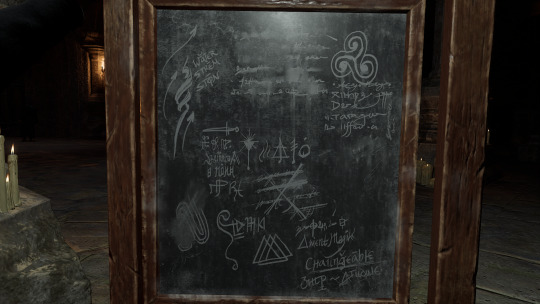
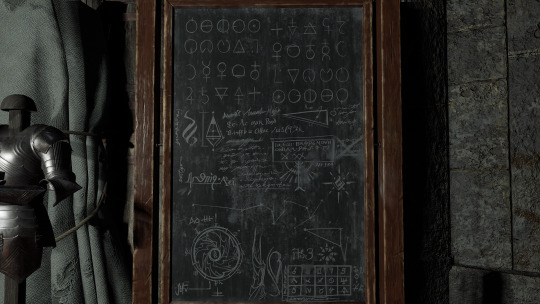
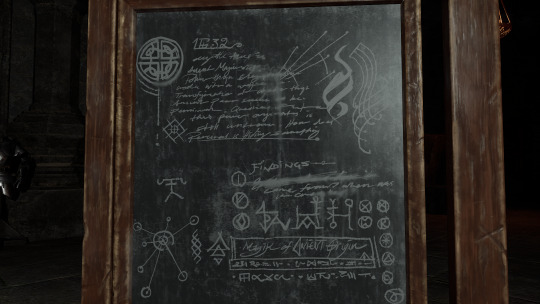
appears before the In the Shadow of the Estate quest.
Few attempts on text legibility were made here and in the reblogs of that post. And no, these notes do not belong to Sebastian -- it is a headcanon.
We do not know the author. Howevor, Isidora is the most probable candidate for the authorship due to the name 'Percival' appearing but the what is likely a timestamp, 1632, veils on that probability, if to assume it is a timestamp, of course. It might be not. We don't know.
Interestingly, the artist tasked to fill up the boards wrote the spellings of the Middle English words: weter, strem, ston, chaungeable.


Diacritical marks were not widely used in the writings done in this language, if at all. You can read about it in more detail here.
These symbols are the triskelion and the valknut:
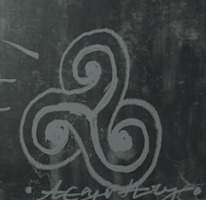

The latter although predates the Viking era, may not be as old as the former; the former is common in many of ancient art, going as far deep into the ancient history as Helladic and Mycenaean eras of the Ancient Greece and the neolithic mound in Meath, Ireland. Weirdly, the stone objects MC can throw with magic have blue-ish carved symbols on their surface; the carvings look somewhat distinctly Pictish, the choose for colour therefore sounds… like it's Let's Throw Everything Ancient To The Region To The Greater Mix Of Things.
This knot:

is the doire / dara knot; symbolises the oak tree, perhaps the most sacred among Celtic people.
This bit could be important to remember: according to this website, Oak's astrological period starts at June 10 and ends at July 7.
These:

are half Alchemy symbols for basic elements (tin, lead, silver, gold, mercury, etc), half transfiguration alphabet as seen from this image:
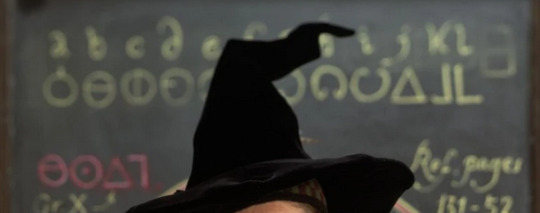
This little fella is Saturn/lead:

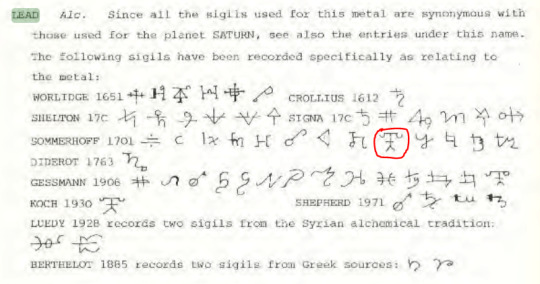
The congregation of the points at the lower left eludes me but the number of points is 7 and the number 7 appears on the end point of the dimensional door aka the wall MC and Sebastian appear at after they are teleported back to the Undercroft from the Isidora's estate:
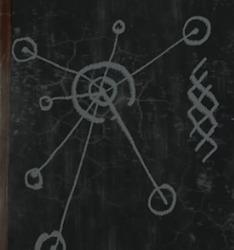

Perhaps it tells us Isidora had 7 hideouts and not 3? Besides, the number 7 is the number of the planets corresponding to the 7 metals:
Sun - Gold - ☉
Moon - Silver - ☽
Mercury - Quicksilver - ☿
Venus - Copper - ♀
Mars - Iron - ♂
Jupiter - Tin - ♃
Saturn - Lead - ♄
Uranus, Nepture, and Pluto aren't a part of Alchemy due to a very simple reason: by the time Uranus was officially discovered in the 1781, Robert Boyle had already published the book The Sceptical Chymist: or Chymico-Physical Doubts & Paradoxes, in 1661. He'd effectively removed the word 'Alchemy' from the use and replaced it with the word 'Chemistry', thus also avoiding the confusion between branches of Alchemy that did research on various materials (that includes spagyric teachings; Paracelsian physicians were the people turning poisons into cures and remedy) -- and what people inspired by Hermes Trismegistus developed smooshing many different things together, such as philosophy, alchemy, astrology, etc, creating a wtf.
I'd say it gives geodesy but may also be a weird depiction of the sal commune err common salt:


What to say about these I can't decide, but they look like ~compound names for various alchemical substances, from left to right: Spiritus Fumans (Stannic Chloride), Aqua Tofana (the infamous tasteless belladonna poison), and Verdigris (Carbonate of Copper, once used as a green pigment; was mildly toxic):
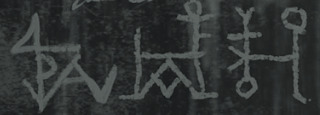
What it's supposed to mean eludes me, besides, it is an assumption.
What I suppose it should mean: something Isidora, if that belongs to her, found; all things besides Verdigris were discovered after her death in the late 1400s, however, there is a person who could've been trying to decipher… these things.
In the In the Shadow of the Undercroft quest Sebastian mentions:
No, someone in his family knew about it [the Undercroft]. The Gaunts are full of secrets.
That Gaunt should've been alive in 1632, assuming it is a timestamp. They also needed to be at school at the time, so could be a professor, a member of the staff (a gamekeeper, for example), a Headmaster; unlikely it was Corvinus Gaunt, who was a student by the time the castle would receive plumbing update (late 17th--early 18th century).
'Aura? Ancient Magik' has to become my favourite kind of explaining things to meself because I, too, have no idea what this means:

I can only tell some text is in Greek. An attempt to type after this bit yielded some results:
Ιαεω is probably Ιασω, recovering&recuperation;
ΒαθρεμονΝΟΝΙΛα is probably βαθμολογία, a degree of smth or a grade;
ρπδ is a greek numerical for 184;
φ, a golden ration mention?;
πδ has to do with the Ptolemy's table of chords?
May not be linked to the much speculated Ancient Magic's capability of healing anything but more so of a celestial body's movement, tied, anyhow, to the Magic's power. Probably.
Speaking of which, Is this the constellation of Lacerta? The number of stars doesn't match, however. Lacerta has 9, this one appears to have 10 or 11; likely 11 + it has a satellite constellation of just 3 stars. I summon astronomy nerds to solve this one + the text and the table below is likely have something to do with Astronomy. I might also suggest: weirdly drawn Draco.
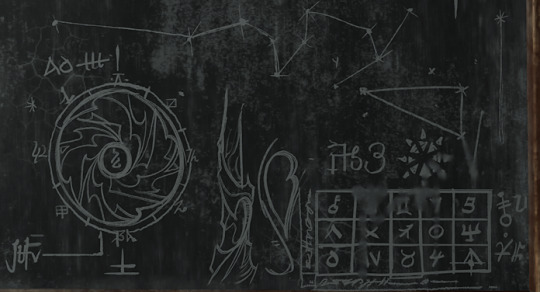
#днявочка#днявочка: hlegacy#днявочка: игры#hogwarts inquires#eng tag#hogwarts legacy#sebastian sallow#ominis gaunt#hogwarts did-you-knows#днявочка: screencaps
79 notes
·
View notes
Note
Emperor was born on Old Earth during prehistoric times before even the Age of Terra, somewhere in ancient central Anatolia (modern Turkey) in the 8th Millennium B.C.
The 8th millennium BC spanned the years 8000 BC to 7001 BC (c. 10 ka to c. 9 ka). In chronological terms, it is the second full millennium of the current Holocene epoch and is entirely within the Pre-Pottery Neolithic B (PPNB) phase of the Early Neolithic. It is impossible to precisely date events that happened around the time of this millennium and all dates mentioned here are estimates mostly based on geological and anthropological analysis, or by radiometric dating.
Because of this, the man probably gooned over figures such as Venus of Willendorf or Venus of Moravany. He HAS to be into bigger people (the exception being Malcador because they definitely fucked and the man was definitely thinner than a twig, in contrast to the Emperor's perfect, oiled form). The Emperor is a bisexual and kinky mf, with the genetic makeup going onto his sons and some of his creations
Comrade it is 5 in the morning we are not timelining the Emperor’s kinky genes right now XD
32 notes
·
View notes
Text

The 'stone age' covers a vast span of time and can be loosely divided up into three general ages: The Paleolithic (the old stone age), the Mesolithic (the middle stone age), and the Neolithic (the new stone age).
The Paleolithic can be further divided into three general ages: The lower, middle, and upper Paleolithic. These cover from 3.3 million to 12,000 years ago, which also cover hominoid development from Homo habilis to Homo sapiens.
[Image text below]
Old Stone Age Chronology
01: Lower Paleolithic (3.3 million to 300,000 years ago)
Pre-modern humanoids gathered into bands of hunter/gatherer societies that used knapped stone tools as well as wood and bone tools. Artistic expression begins with beads and ‘Venus’ figures. Early evidence of cooking. Evidence of rafts to cross bodies of water.
02: Middle Paleolithic (300,00 to 50,000 years ago)
More control over stone tools using prepared cores, which allowed the development of weapons like spears and bows, allowing larger animals to be hunted and larger groups to be supported. Possible flute-like instruments made of bones. Clothing began being used.
03: Upper Paleolithic (50,000 to 12,000 years ago)
Development of nets, bolas, spear throwers, as well as the development of pottery. Evidence of navigation as far as 60 km off-shore. Dogs domesticated to aid with hunting (perhaps as early as middle paleolithic). Earliest evidence of lunar calendars. Cave art painted.
04: Human development in this period
During this time, the genus Homo developed from Homo habilis through Homo erectus, Homo neanderthalensis, and finally to Homo sapiens, which evolved approximately 300,000 years ago, though behaviorally modern humans evolved approximately 50,000 years ago.
[End image text]
5 notes
·
View notes
Text
Pinterest just took down my pin of the Venus of Willendorf / Nude Perspective of the Self post for being "adult content". It was a neolithic statue. And a grainy photograph that allegedly contains a female presenting nipple, but like, for scientific purposes. You've all seen it.
The appeal link was broken too
19 notes
·
View notes
Text
i found this awesome artist Libor Balák who paints a lot of prehistoric reconstructions for museums etc. i did already know some of his paitnings but wasn't aware what his name is... he deserves to be recognised for his works... so here are his reconstructions of the Lengyel culture taken from his website (one of my favourite cultures btw)
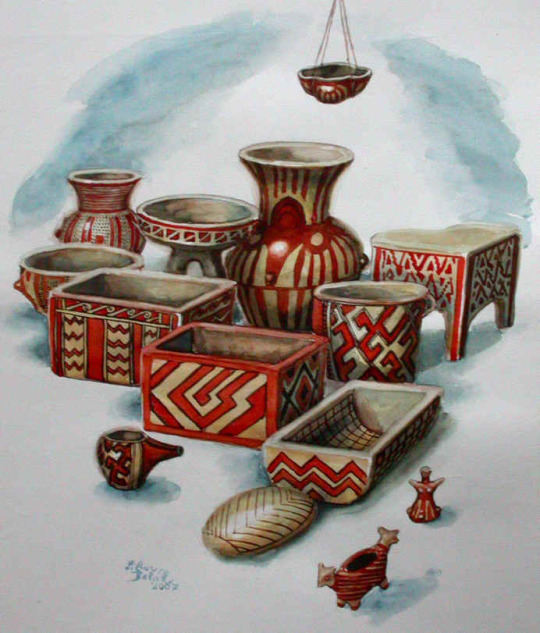
This Neolithic culture has left a distinctive archaeological signature centred in southern Moravia, but also included southwest Slovakia and adjacent parts of Austria and Hungary. Temporally belongs to late Neolithic – about 5000 B.C.
Colourfully decorated ceramics constituted a distinct element of this culture, which subsequently spread into northern Poland, Bohemia and central Germany. Apart from pots, ceramic spoons, ladles, cubic lamplets and models of various objects and structures are known from southern Moravia. This society also possessed advanced agriculture.

Model of a small dwelling is transformed into reality
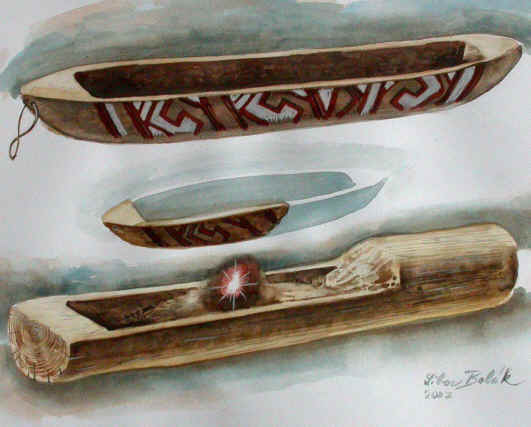
Ceramic fragment labelled as a ship is transformed into watercraft decoration – a monoxylon manufactured from a single piece of tree trunk

The meaning of the nakedness of the figurines is also controversial; some of the figurines could have had clothes painted on them..
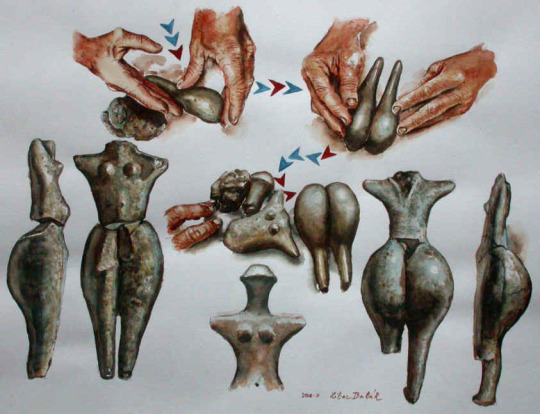
The painting displays the technological stages of Venus figurine manufacture
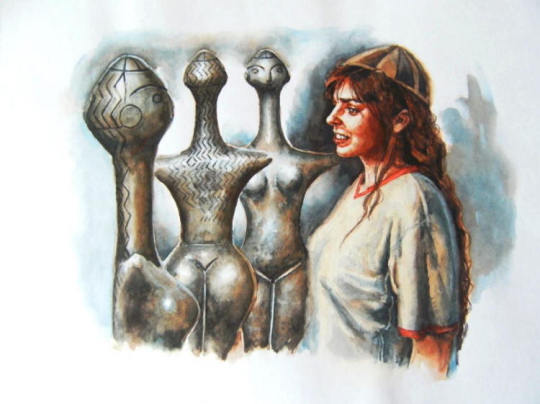
The Middle European Lengyel statuettes are first of all of a high handcrafted quality and very decorative. The shapes and patterns are taken over from the earlier statuettes. Some of them bear specific anatomical and ethnographic elements, such as the Venuse with schematic curly hair.

This statuette has schematic straight hair.
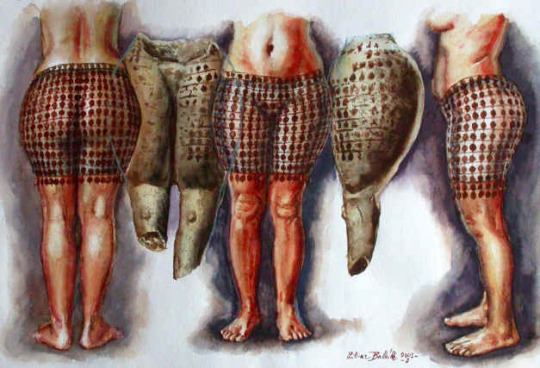
One of the many pieces of the Venus figurines from Neolithic era, found in South Moravia. This fraction has a preserved coloration with geometrical patterns.The figurine is uncomplete, it could also have had complet clothing.

The figurine of a woman in a skirt is decorated with ceramic lugs. The statuette could also be wearing a complete dress, not only a skirt on a bare body
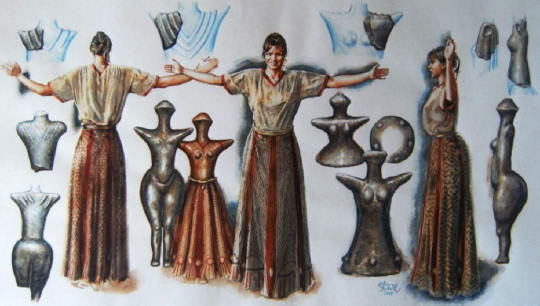
The reconstructive transformation on this picture analyzes the skew elements in the place of the shoulder blades – it could be draped textiles

On this statuette found in Austria we can see the preserved traces of the original painting. The interesting fact is also the hole between it´s tights. It could serve for interlacing of the waistcloth or, less probably, for fixing of the figure to the base; the fingertips would hinder the perfect fixing. The image represents the possibilities of the painting interpretation – the decorative leggings on the tights, tattooes, paintings on the skin and a necklace in the form of boar tusks. We can also see the decoration on the neck.
#lengyel culture#neolithic#archaeology#prehistory#stone age#figurines#female figurines#pottery#artefact#reconstruction#anthropomorphic figurine#my upl#Libor Balák#art#czech art
12 notes
·
View notes
Text
The flat stomach was not always an aspect of the ideal female form. Idealized women’s bodies in artistic representations tended to be symmetrical. However, rounded or fleshy (rather than flat or muscular) abdomens were the norm in ancient and Renaissance art
i was reading cultural encyclopedia of the body and it said this but idk if its like...true? like. here are some results for ancient greek statues of naked women
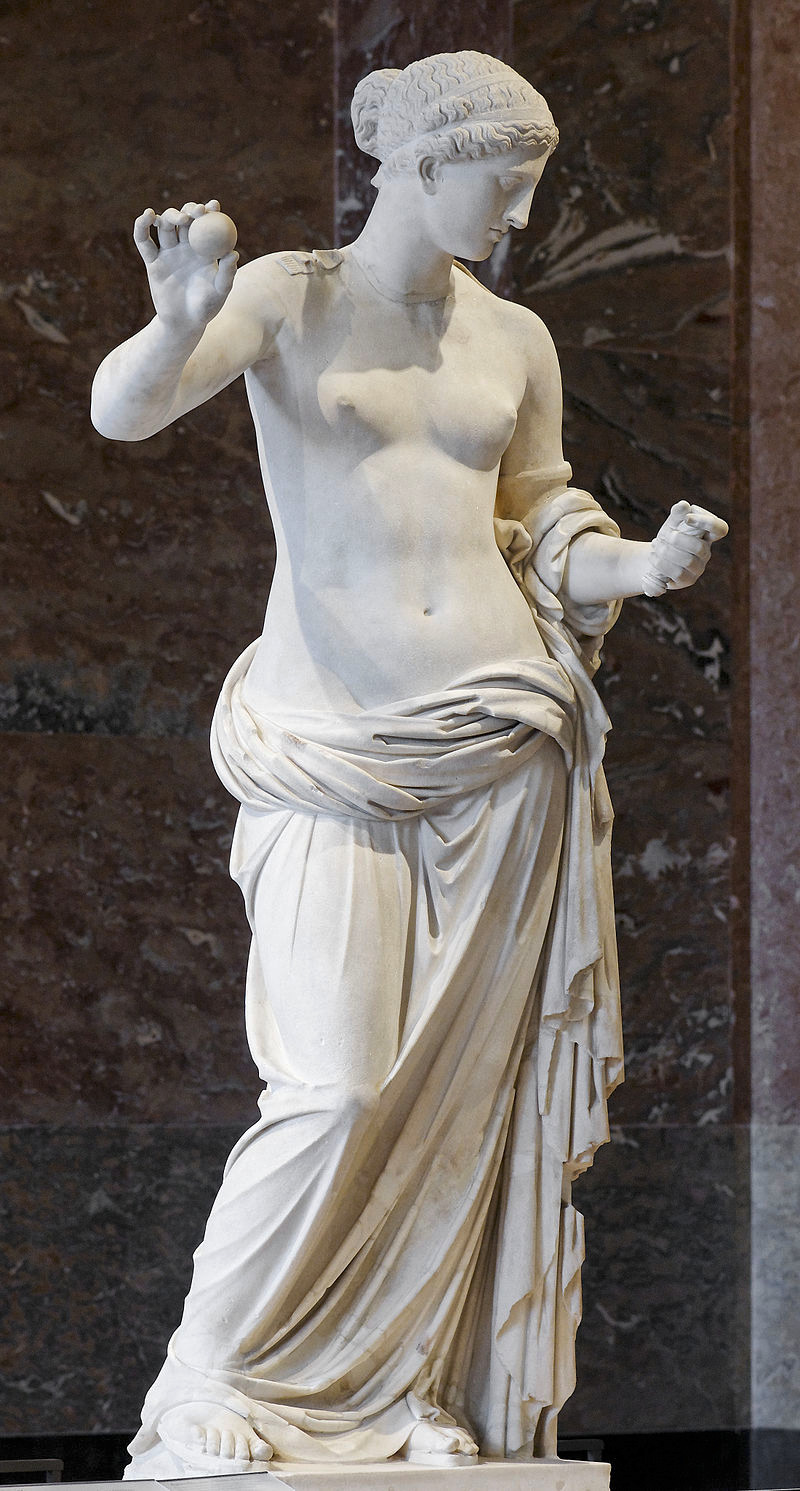
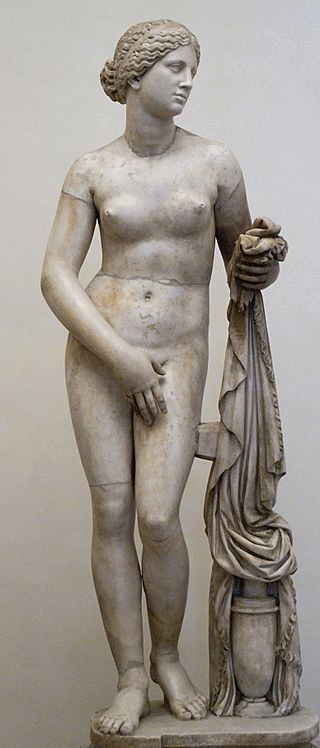
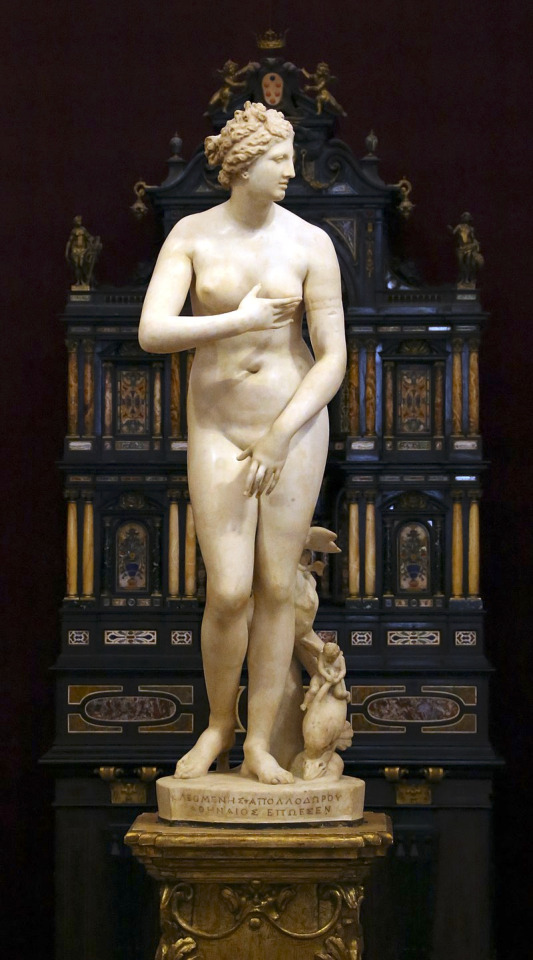
note their stomachs! pretty flat!
and its not just venus (as above). bam, ishtar!
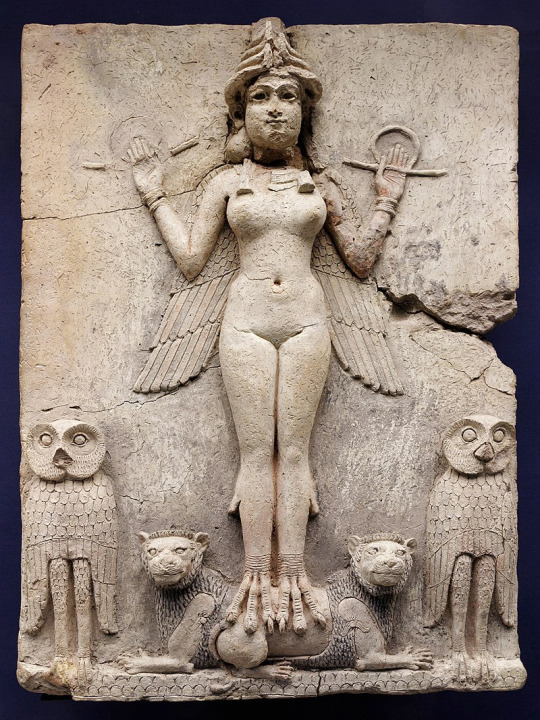
this article mentions crouching venus, who doesnt totally have a flat stomach?
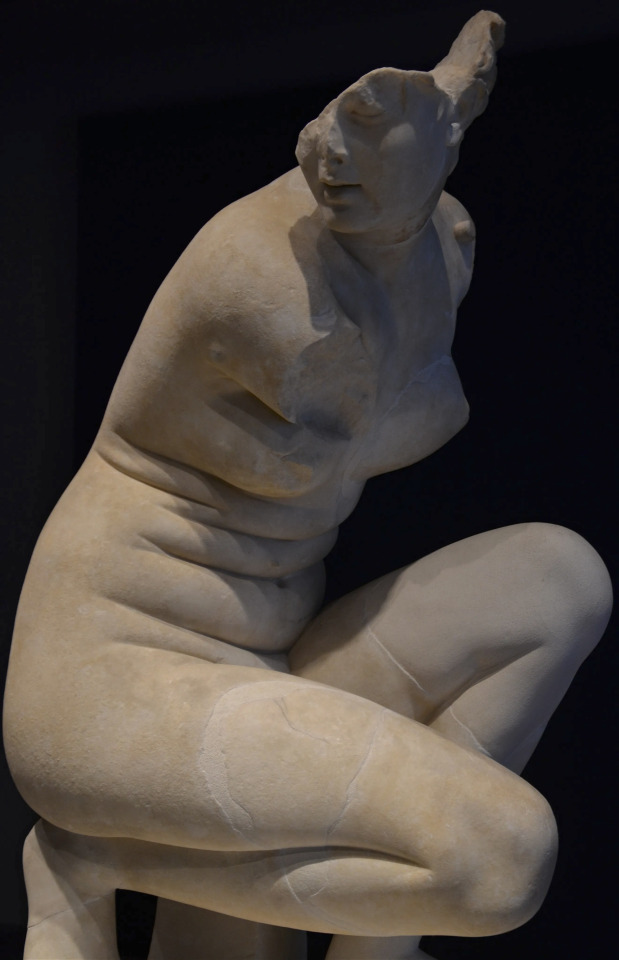
but like. literally everyones stomach looks like that when they crouch. and bend over. i think this is still unambiguously someone with a flat stomach!
i mean there definitely were neolithic statues without flat stomachs. but they seems strangely uncommon after that!
31 notes
·
View notes
Text
Hi I am het but Lord y’all I am going to never shut up about pretty fat women. My demisexual ass prefers men but I am aesthetically pleased by women that have huge thighs and soft squishy tummies.
Rock that Willendorf Venus body ladies! We are built to survive famine and plague and the modern world wants to tell us that our “extra” thirty pounds will kill us when it’s already been proven that most metabolic diseases don’t have fuck all to do with weight as much as diet!
I was a rolly-poly ass teenager and I would consistently do better running laps than the skinny minis around me. In college my aerobics instructor complimented me on my stamina.
Fat has never automatically meant unhealthy and I will fight anyone who says so. Fat is how our bodies guard us from the lean times. Fat is energy, strength, and guards our organs.
I could eat the right diet and do the right amount of exercise but I’ll never not have a huge ass and big tits and that’s beautiful because it means I’m built to survive and thrive bitches! I am the image of the mother goddesses of the Neolithic, I have the fat rolls of the Hellenic Aphrodite, I have the pear shape of Rueben’s nude muses!
Fat girls, chunky men, thick enbys and all the generously-fleshed folks in between, you are not a stupid number on a fucking scale! Dress up!!! Do your makeup!!! Give the world a smile!!! You have the same potential as any one else to be someone’s dream hottie!!!
Meanwhile, I will never shut up about pretty fat women!!!
4 notes
·
View notes